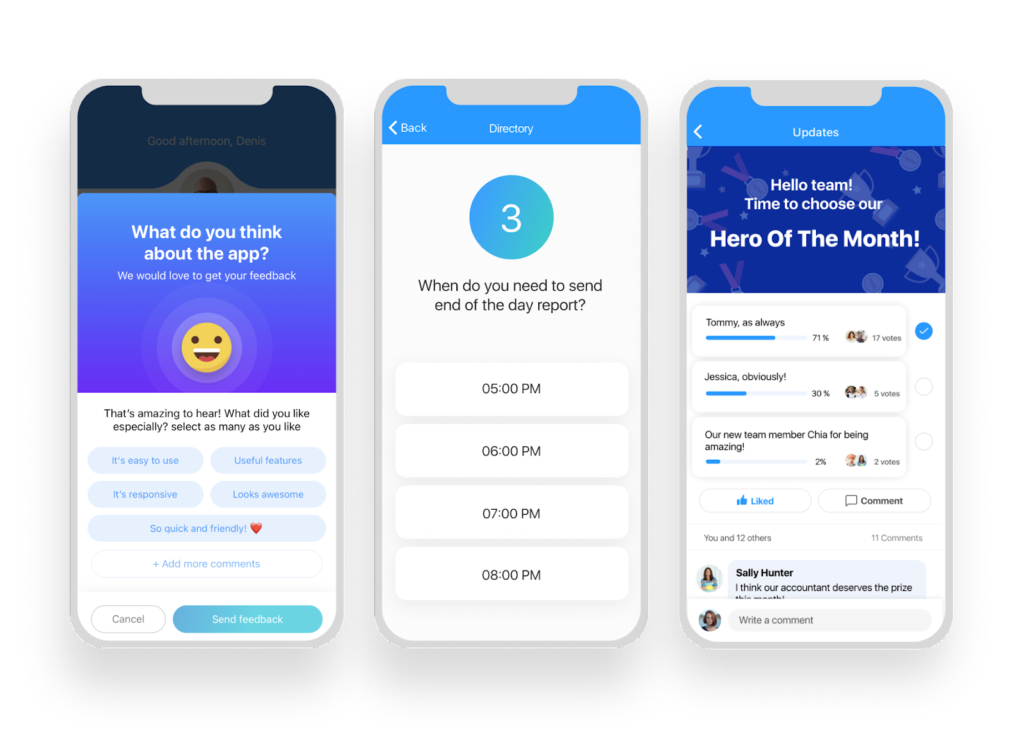Collecting feedback from your workers is key to improving productivity, engagement, and retention. In this article, we discuss 8 easy ways to collect feedback in your company as well as best practices.
Failing to collect and consider employee feedback can negatively impact workplace harmony and overall business success. Employees who feel unsupported or undervalued but can’t communicate this will feel demotivated.
They might underperform or even quit. Even motivated employees won’t feel like valued contributors if you don’t give them a way to share their thoughts—and you’ll miss out on potentially valuable ideas.
Unfortunately, many companies don’t bother collecting employee feedback. They mistakenly believe it’s time-consuming, costly, or pointless.
In this guide, we discuss why gathering employee feedback is critical to company success.
We also explain how to get feedback from employees in 8 simple but effective ways so you can pick a method that best suits your needs.
Key Takeaways
- Employee feedback is critical to improving your company’s culture and employee experience.
- You can collect feedback through surveys, focus groups, town halls, regular check-ins, performance reviews, and exit interviews with departing workers.
- Further, suggestion boxes and polls let you collect employee opinions and ideas in real time.
- Employee feedback collection methods simplify the process and reduce errors in feedback collection and analysis.
Why Collect Employee Feedback?
Receiving feedback from your workers can benefit your business in several ways.
Improves employee engagement and retention
Feedback lets employees express their concerns, share ideas, and participate in company decisions. These factors boost employee engagement—encouraging workers to perform above and beyond.
Moreover, it helps you understand your team members and make informed decisions about how to improve your company culture.
Finally, when an employee feels heard and valued, they’ll have higher employee satisfaction. Plus, they’re more likely to stay in their jobs—reducing turnover in your company.
Enhances performance
Workers often encounter day-to-day issues you’re unaware of. Feedback provides valuable insights into these problems, enabling you to address them. This way, your workers can operate in an environment where they feel supported and can thrive.
Furthermore, workers often have unique perspectives and ideas that can improve processes and productivity. When you gather feedback, you’re giving them a platform to share these ideas—and boosting innovation.
Attracts top talent
Employee feedback can also help with recruitment. For instance, say employees have revealed through feedback that flexibility scheduling is important. You might consider offering it as a benefit to attract new talent.
Plus, you can use existing employees’ positive experiences as testimonials on your website. This can strengthen your employer brand and make you stand out in the job market.
Fosters a culture of open and honest communication
Feedback channels encourage open, 2-way communication between management and employees. It creates a culture where dialogue is encouraged and employees feel comfortable sharing thoughts and concerns.
Further, actively seeking and acting on employee feedback builds trust. It shows your workers your company values their opinions and is committed to creating a positive work environment for them.
How To Get Feedback from Employees: 8 Best Ways
Here are 8 employee feedback collection methods you can easily implement in your company.
Surveys

Surveys are among the most popular employee feedback collection methods. They’re questionnaires you can roll out to workers to gather feedback.
These can include specific questions to gather insights on timely topics—like a recent policy change. Or, you can roll out regular surveys that collect feedback on consistently relevant topics, like team dynamics or employee wellness.
This Might Interest You
Read our guide on employee wellness surveys, including thoughtful sample questions and a template you can use.
The best surveys contain a mix of clear and easy-to-understand questions that collect numerical and descriptive data. Examples include “On a scale of 1-5, how satisfied are you with your workplace environment?” and “Describe a situation where you felt particularly supported by your team.”
Here are a few types of employee surveys you can consider using to gather feedback.
Employee engagement and satisfaction surveys
These types of surveys measure overall job satisfaction and employee motivation. They ask workers about factors like communication, teamwork, career development, work-life balance, and leadership.
Employee engagement or satisfaction surveys usually happen annually or once every 6 months because they’re more detailed and take longer to complete.
On the plus side, they provide you with holistic and actionable insights to improve company culture. Also, you can track how feedback changes over time to see what’s working and what should change.
This Might Interest You
Our guide on employee engagement surveys includes sample questions, a free template, and help with analyzing results.
Pulse surveys
These short, frequent surveys aim to capture the overall “pulse” of the organization—meaning, how employees currently feel about the culture and working practices. Use pulse surveys to ask employees about their opinions on your company’s people practices, ongoing projects, recent changes, and more.
Roll these out monthly or quarterly, but ask 20 questions at most so workers can complete them in about 5-10 minutes. Otherwise, you’ll risk employees facing survey fatigue, which could compromise the quality and accuracy of their responses.
Onboarding surveys
You can roll out an onboarding survey shortly after new hires have completed their onboarding process. Ask questions about their experience with the application process, onboarding and training, management support, and more. Use the insights to fine-tune your processes and improve the new employee experience.
Pro Tip
Consider using an employee onboarding app to provide your new recruits with a positive and seamless experience.
New employee surveys
Consider asking new hires to complete a survey after the first 3 months of joining. This is a great way to check in with them and ensure they’re settling well into their jobs and feel supported by team members.
Did You Know?
Connecteam lets you create and customize employee communication surveys with your own questions. Deliver these straight to employees’ smartphones. You can even send reminders, track response rates, and analyze reports.
Focus groups
In this method, companies gather small groups of employees to have moderated and focused discussions on specific topics. This is a powerful method for gathering employee feedback on various aspects of the company’s culture. Here’s how to conduct an effective focus group.
- Identify specific topics or issues to discuss, such as company culture, new policies, or team dynamics.
- Select the participants you want feedback from. This may be a specific team or a diverse set of employees that represent the overall company.
- Set a time, date, and location—it could be virtual—for the group to meet.
- Appoint a skilled facilitator to guide the discussion, ensure that everyone has a chance to contribute, and keep the conversation focused.
- Encourage open dialogue and assure employees that they’ll face no retaliation for being honest.
- Take notes to capture the key points and feelings expressed.
- Create a list of action items, and work towards improving employee experiences in the areas discussed.
While this method is time-consuming and not easily scalable, it can provide you with rich context in ways surveys might not. Consider using this method to follow up on specific topics that emerged in survey results.
Pro Tip
Appointing an unbiased external or internal facilitator and assuring employees that their feedback will be anonymized can help them feel comfortable with openly sharing their opinions.
Manager check-ins and skip-level meetings
Managers should schedule regular—for example, twice monthly—1-on-1 check-ins with their direct reports. These check-ins can provide your employee with a consistent and trusted platform to discuss their progress and challenges and share feedback so you can address any issues promptly.
It also gives you and your workers a chance to provide timely feedback. For example, if a worker is unhappy with how leadership handled a recent issue, they should have the opportunity to share this feedback sooner rather than later. Long wait times deteriorate the quality of feedback. Worse—employees might talk themselves out of sharing their opinions.
However, these check-ins don’t need to be restricted to managers and their employees. Consider encouraging skip-level meetings in your company. This is where workers have a chance to share their thoughts, opinions, and concerns with senior managers or leaders, bypassing the direct chain of command.
Skip-level meetings allow workers to provide feedback on topics they wouldn’t feel comfortable discussing with their manager. For instance, if an entire team is unhappy with their manager, team members may share their concerns with a senior leader during a skip-level meeting. This can then translate to the leader taking action or involving HR to investigate the situation before it gets worse.
Finally, skip-level meetings also show employees that their leadership cares about them and isn’t out of reach. A strong trusted relationship between employees and company leaders can help employees feel connected to the company.
Did You Know?
Connecteam’s online team chat is a great way for employees to connect with management instantly in 1-on-1 or group settings. This shows employees that support isn’t available only during check-ins—it’s always a few touches away.
Suggestion boxes and polls
Employee feedback isn’t just worker complaints. Workers should also have the opportunity to share ideas and opinions on company decisions.
Some employees have great ideas but don’t have a proper platform to discuss them. Others might be shy or afraid to voice their opinions. Suggestion boxes and live polls resolve this.
Suggestion boxes
Companies operating from a physical location such as a store, restaurant, or clinic can strategically place a suggestion box in an accessible but discreet area. Workers should feel comfortable dropping their anonymous feedback into the box.
Appoint one person to regularly empty the box—for instance, at the end of each week—and ensure you review and implement suggestions as appropriate.
Pro Tip
Consider using a digital suggestion box rather than a physical one. Employees can make anonymous suggestions from anywhere, you can save suggestions long-term, and it’s easier to manage.
Polls

Polls let you collect employees’ opinions and votes in real time—when you need them. For example, you might want to get your team’s input on a new opportunity.
Ask them questions like, “Do you have the capacity to work on a new project this month?” This way, you can make better business decisions.
Pro Tip
Use polling apps like Connecteam to gather workers’ opinions in real time and from anywhere. You can also collect feedback anonymously to encourage honest responses.
Performance reviews and 360-degree feedback
Performance reviews are structured conversations between managers, employees, and sometimes HR. You can use these conversations to let your workers know how they’re performing. You can also invite employees to give feedback on their satisfaction with management, team dynamics, and the support they receive from the company.
Further, many companies use 360-degree feedback tools as part of the performance appraisal process. This tool lets you collect feedback on various employees from their managers, peers, direct reports, and more. Oftentimes, feedback is anonymous.
Managers and leaders can use 360-degree feedback to gain insights into how their team members view them and better understand their own strengths and weaknesses.
Employee forums
Forums like regular standing meetings (repeatedly scheduled team discussions) and company-wide town halls (all-employee meetings for major updates) are great places to gather feedback and foster a sense of community within the company.
Organize such meetings—in person or virtually—to encourage open communication between leadership and employees. While many meetings have fixed agendas, leave a regular slot for workers to share ideas, ask questions, and provide feedback.
Ensure leaders and management actively listen to and address workers’ concerns. Otherwise, employees may not take these sessions seriously. It’s best to document the feedback and discuss how to incorporate it during leadership meetings. After the forum or town hall, share meeting minutes and actions with employees so they know their voices have been heard.
Did You Know?
Connecteam functions as a company event app, providing tools to let you organize in-person or virtual events like forums and town halls. Invite workers, track RSVPs, send reminders, and share event information from a single platform.
Exit interviews
Exit interviews are an effective way to gather candid feedback from departing workers. Here’s how to conduct a good exit interview:
- Schedule an exit interview close to the employee’s departure date rather than immediately after they resign. This way, they have enough time to reflect on their experiences.
- Ensure confidentiality to encourage them to speak openly.
- Assigned skilled interviewers, such as HR professionals or managers, to conduct the interviews with empathy and without bias. Or, consider training some of your existing team members to conduct effective exit interviews.
- Prepare a set of specific questions covering various aspects of the employee experience. For instance, ask about their reasons for leaving, job satisfaction, company support, growth opportunities, and suggestions for improvement.
- Incorporate some open-ended questions to give workers the space to share their own unfiltered thoughts.
- Some employees may be leaving on bitter terms. Encourage them to think through their answers and try to respond without bias.
- Document the feedback and analyze trends across different exit interviews to identify any repeating areas of concern.
Pro Tip
Don’t have the resources to conduct individual exit interviews? Consider rolling out exit surveys. They’re less time-consuming, and some employees might feel more comfortable being honest on a survey rather than in a face-to-face meeting.
Online reviews
Regularly monitor and analyze Glassdoor, Indeed, and other online platforms where employees and former employees share their open and honest thoughts about working for your company. Evaluate the feedback so you can spot recurring themes to address.
For instance, you might find that several reviewers have complained about work-life balance in your company. It’s best to identify and fix this concern before it leads to more exits and damages your employer brand.
Pro Tip
Where justified, engage with the feedback and assure employees that you’re working on improving. Various candidates visit these websites to learn about a company’s reputation before applying for jobs. So, show you care about your employees and their feelings.
Best Practices for Collecting Employee Feedback
Here are our top tips for collecting employee feedback.
Consider who you want feedback from
You don’t always have to collect feedback from your entire workforce. Think about what topics you want feedback on and target workers who can provide that feedback.
For instance, if you want a general sense of your employees’ satisfaction, you may consider rolling out a company-wide survey. But if you’re looking for a department’s feedback about a recent project, you’ll need feedback from that department only.
Choose the right employee feedback collection methods
Consider what your objectives are, and choose the method that’ll work best for your goals.
For example, if you’re gathering suggestions on the company’s next team social, a live poll might be effective. But if you’re looking for feedback on a particular manager who’s up for promotion, you may need to roll out a 360-degree form to their team members and peers.
Did You Know?
You can use Connecteam’s digital forms tool to create custom forms, including 360-degree feedback forms, and deliver them straight to workers’ desktops and mobile phones.
Consider anonymous feedback collection methods
Not every employee is comfortable sharing their views honestly. Despite reassurances, workers may be afraid of retaliation if they say or write something negative about the company or its employees.
Depending on the nature of the feedback, consider letting workers provide their opinions anonymously. For instance, direct reports may prefer to provide anonymous feedback on their supervisors to prevent any negative impact on the relationship.
Did You Know?
Connecteam’s surveys, forms, and polls can all be anonymized so workers feel comfortable discussing their views honestly.
Take action
Collecting feedback is a great way to make meaningful and effective improvements to your company’s culture and working practices. Ignoring feedback wastes resources and causes you to lose face with your staff members.
Use technology
Today, there are many employee survey tools you can use to automate the feedback collection process. Using good software like Connecteam can help you to gather feedback in various forms and easily analyze and action it from a single platform.
Conclusion
Knowing how to get feedback from employees can help you improve company culture, enhance performance, and make your workers feel like valued contributors.
Employee surveys, suggestion boxes, performance reviews, and exit interviews are some of the collection methods you can choose from. Whichever methods you pick, ensure they align with your needs, encourage honest responses, and give you actionable feedback.
Finally, don’t make feedback collection a time-consuming and manual process. Consider using software like Connecteam to streamline surveys, polls, feedback forms, forum planning, and so much more.
Get started with Connecteam for free today!
FAQs
How do I get genuine feedback from employees?
The most effective way to get genuine employee feedback is to create a culture where workers feel safe sharing their opinions without negative consequences. Do this by actively seeking feedback and showing you’re taking it into account. Additionally, anonymizing feedback collection also enables genuine employee feedback.
What questions should I ask in a feedback session?
The specific questions you ask in feedback sessions depend on your goals for the session. For example, if you’re looking for feedback on a recent wellness initiative, ask employees if they participated in the initiative and how satisfied they were with the results. Generally, include a mix of questions (like number-based and open-ended questions).

